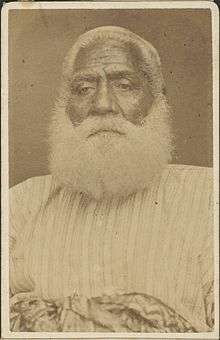Seru Epenisa Cakobau
Ratu Seru Epenisa Cakobau (pronounced [ˈseru epeˈniːsa ðakomˈbau]; occasionally spelled Cacobau or phonetically Thakombau) (c.1815 – 1 February 1883)[1] was a Fijian Ratu and warlord (Vunivalu) who united part of Fiji's warring tribes under his leadership, establishing a united Fijian kingdom.[2]
| Seru Epenisa Cakobau | |
|---|---|
| King of Fiji 6th Vunivalu of Bau King of Bau | |
 | |
| King of Fiji | |
| Reign | 5 June 1871 – 10 October 1874 |
| Successor | Victoria |
| Born | 1815 Natoloa Nairai, Lomaiviti |
| Died | 1 February 1883 (aged 67–68) |
| Spouse | Adi Litia Samanunu Adi Salote Qalirea Kaunilotuna |
| Issue | Children by Adi Litia Samanunu: Adi Arieta Kuila Ratu Epeli Nailatikau I Adi Asenaca Kakua Vuikaba Ratu Timoci Tavanavanua Ratu Josefa Celua Children by Adi Salote Qalirea Kaunilotuna: Ratu Sukuna Vana Ratu Viliame Bulu Adi Lusiana Qolikoro |
| Father | Tanoa Visawaqa |
| Mother | Adi Savusavu |
| Religion | Methodist |
| Signature |  |
.jpg)
Background
He was born to Ratu Tanoa Visawaqa, and one of his nine wives, Adi Savusavu.
The Vunivalu and the Roko Tui Bau (sacred chieftain) had had many power struggles during the course of nearly a century. These struggles led to the death of Seru's paternal uncle, the Vunivalu of Bau, Naulivou Ramatenikutu and the installation of Tanoa as Vunivalu. However, after he killed the Roko Tui Bau, Ratu Raiwalui, near Vanua Balavu, amongst other murders and reprisals, Tanoa was exiled in 1832.
Ratu Seru Cakobau was born on Nairai Island but raised on Gau Island. In his early twenties, he returned to Bau. He subsequently gained power in 1837 when he persuaded the Lasakau people to overthrow the Roko Tui Bau Vuani-ivi clan led by Ratu Ravulo Vakayaliyalo. Seru then reinstated his father as the ruling Vunivalu in Bau.
He married two sisters, Adi Litia (Lydia) Samanunu and Adi Salote (Charlotte) Qalirea Kaunilotuna (daughters of the Roko Tui Bau). [3]
Mary Wallis provided a description of him after meeting with him on 7 December 1844: "He is tall, rather good looking, appears fully aware of his consequence, and is not destitute of dignity. He wore an enormous quantity of hair on his head and several yards of native cloth around his body..." [4]
Seru was given the name Cikinovu ("Centipede"),[2] "because he moved silently and struck painfully". Later, he was called Cakobau ("destroyer of Bau"), because he had destroyed what was Bau; but Seru also built a new Bau, under the supremacy of the Vunivalu. After he converted to Christianity, he took additional name of Epenisa (Ebenezer).[5]
Rise to power
On 8 December 1852, Cakobau succeeded as Vunivalu of Bau.
Cakobau, a former cannibal, was converted to Christianity by the missionary James Calvert[6] and renounced cannibalism in 1854.
Claiming that Bau had suzerainty over the remainder of Fiji, he asserted that he was, in fact, the King of Fiji. However, Cakobau's claim was not accepted by other chiefs, who regarded him, at best, as the first among equals. Cakobau consequently engaged in constant warfare for almost nineteen years to unify the islands under his authority.
The last, brief rebellion of chiefs against Cakobau's rule culminated in the Battle of Kaba (a village in Bau Tikina, next to Bau Island). Cakobau crushed the rebellion with the aid of the King of Tonga. Having become a Christian, Cakobau on the battlefield pardoned all the captives; in accordance with pagan Fijian customs, the defeated men would have been ceremonially humiliated, killed, and eaten.
.svg.png)
On 8 May 1865,[7] a Confederacy of Independent Kingdoms of Viti was established (comprising Bau, Bua, Cakaudrove, Lakeba, Macuata, Naduri), with Cakobau as Chairman of the General Assembly. Two years later, however, the confederacy split into the Kingdom of Bau and the Confederation of Lau (comprising Bua, Cakaudrove, Lau), with Cakobau assuming kingship of the former.
Supported by foreign settlers, he finally succeeded in creating a united Fijian kingdom in 1871, and established Levuka as his capital. He decided to set up a constitutional monarchy, and the first legislative assembly met in November of that year. Both the legislature and the Cabinet were dominated by foreigners.
Cession of power
The United States government had recognised Cakobau's claim to kingship over a united Fijian nation, long before his claims were accepted by his fellow chiefs. In the long term, however, this was not to count in his favour. The American government held him responsible for an arson attack against the Nukulau Island home of John Brown William, the American Consul, in 1849 (before Cakobau was even the Vunivalu, let alone King), and demanded $44,000 compensation. Unable to pay the debt caused by the Rewan Chiefs, and fearing an American invasion and annexation, Cakobau decided to cede the islands to the United Kingdom.[8]
Cakobau retained his position as Fiji's second most senior chief the title of Vunivalu of Bau, and formally ceded the highest and most precedent Chiefly title of Tui Viti or Paramount Chief of Fiji to the person of Her Majesty Queen Victoria. This title continued to be held by her descendants, until the de-establishment of the Great Council of Chiefs on 14 March 2012, making Elizabeth II the last Paramount Chief. He lived quietly until his death on 1 February 1883.[2]
Legacy
Several of Fiji's leading figures were direct descendants of Cakobau. His great-grandson, Ratu Sir George Cakobau, served as Fiji's first native-born Governor-General from 1973 to 1983. Ratu Sir Kamisese Mara, modern Fiji's first Prime Minister and second President, was also a descendant of Cakobau's. Ratu Epeli Nailatikau, the grandson of Cakobau's daughter Adi Litia Cakobau, became President of Fiji in 2009. A number of other political figures are also descendants of Cakobau, including Roko Tupou Draunidalo, President of the National Federation Party and a Member of Parliament since 2014.
Titles
| Preceded by Tanoa Visawaqa |
Vunivalu of Bau 8 December 1852 – 1 February 1883 |
Succeeded by Epeli Nailatikau I |
| Preceded by none (new office) |
Chairman, Viti Confederacy 8 May 1865 – 2 May 1867 |
Succeeded by none (office abolished) |
| Preceded by none (new throne) |
Tui Bau (King of Bau) 2 May 1867 – 1869 |
Succeeded by none (throne abolished) |
| Preceded by none (new throne) |
Tui Viti (King of Fiji) 5 June 1871 – 10 October 1874 |
Succeeded by Queen Victoria |
See also
| Wikimedia Commons has media related to Seru Epenisa Cakobau. |
- Fiji during the time of Cakobau
- First Fiji Expedition
- Second Fiji Expedition
References
- Genealogy
- Mennell, Philip (1892). . The Dictionary of Australasian Biography. London: Hutchinson & Co – via Wikisource.
- Genealogy
- Wallis), a lady (Mary (2002). Life in Feejee : five years among the cannibals, a woman's account of voyaging the Fiji Islands aboard the "Zotoff" (1844-49). Santa Barbara, Calif.: Narrative Press. p. 16. ISBN 1-58976-208-8.
- Thornley, Andrew (2002). Exodus of the I Taukei: The Wesleyan Church in Fiji, 1848-74. Suva: Institute of Pacific Studies, University of the South Pacific. p. 176. ISBN 978-982-02-0340-2.
- Mennell, Philip (1892). . The Dictionary of Australasian Biography. London: Hutchinson & Co – via Wikisource.
- Worldstatesmen
- Lawrence, David Russell (October 2014). "Chapter 5 Liberalism, Imperialism and colonial expansion" (PDF). The Naturalist and his "Beautiful Islands": Charles Morris Woodford in the Western Pacific. ANU Press. pp. 139–140. ISBN 9781925022032.
- Eddie Dean; Stan Ritova (June 1988). Rabuka: no other way. Doubleday. pp. 32, 36, 71. ISBN 978-0-86824-372-6. Retrieved 25 June 2011.
- Kathleen Hancock (2003). Men of mana. Steele Roberts. ISBN 978-1-877228-62-9. Retrieved 25 June 2011.
- David Routledge; University of the South Pacific. Fiji Centre; University of the South Pacific. Institute of Pacific Studies (1985). "Chapter 2 Struggle between the Chiefs 1760 to 1842". Matanitu: The Struggle for Power in Early Fiji. Institute of Pacific Studies in assoc. with the Fiji Centre Extension Services, Univ. of the South Pacific. pp. 40, 56. Retrieved 25 June 2011.
- Ratu Sir Kamisese Mara; Pacific Islands Development Program (East-West Center) (1997). The Pacific way: a memoir. University of Hawaii Press. ISBN 978-0-8248-1893-7. Retrieved 25 June 2011.
- Alfred Reginald Radcliffe-Brown; Raymond William Firth; Adolphus Peter Elkin (1977). Oceania: a journal devoted to the study of the native peoples of Australia, New Guinea, and the islands of the Pacific Ocean. University of Sydney. Retrieved 25 June 2011.
- Marshall David Sahlins (2004). Apologies to Thucydides: understanding history as culture and vice versa. University of Chicago Press. ISBN 978-0-226-73400-2. Retrieved 25 June 2011. Reference to the sanctity of the Roko Tui Bau and also the battle near Vanua Balavu. Also the continued friction between the Roko Tui Bau and The Vunivalu.
- Lewis F. Petrinovich (2000). The cannibal within. Aldine de Gruyter. p. 135. ISBN 978-0-202-02048-8. Retrieved 25 June 2011. Includes details on cannibalism in Fiji.
- Thomas Williams; James Calvert (1858). Fiji and the Fijians. A. Heylin. pp. 213–214. Retrieved 25 June 2011. Includes details on cannibalism in Fiji.